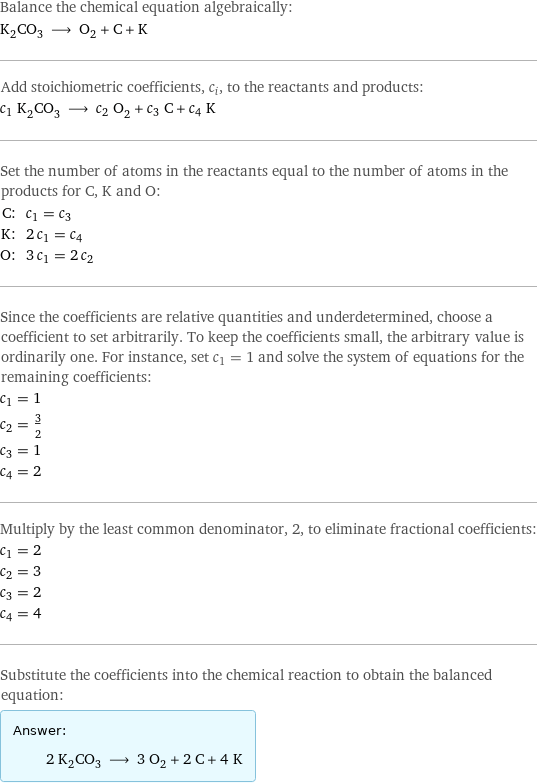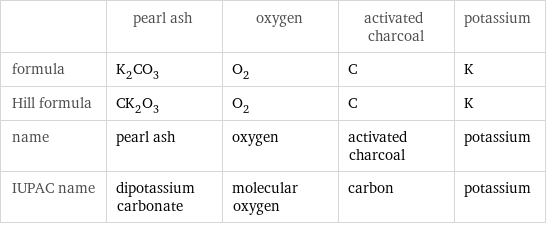Input interpretation

K_2CO_3 pearl ash ⟶ O_2 oxygen + C activated charcoal + K potassium
Balanced equation

Balance the chemical equation algebraically: K_2CO_3 ⟶ O_2 + C + K Add stoichiometric coefficients, c_i, to the reactants and products: c_1 K_2CO_3 ⟶ c_2 O_2 + c_3 C + c_4 K Set the number of atoms in the reactants equal to the number of atoms in the products for C, K and O: C: | c_1 = c_3 K: | 2 c_1 = c_4 O: | 3 c_1 = 2 c_2 Since the coefficients are relative quantities and underdetermined, choose a coefficient to set arbitrarily. To keep the coefficients small, the arbitrary value is ordinarily one. For instance, set c_1 = 1 and solve the system of equations for the remaining coefficients: c_1 = 1 c_2 = 3/2 c_3 = 1 c_4 = 2 Multiply by the least common denominator, 2, to eliminate fractional coefficients: c_1 = 2 c_2 = 3 c_3 = 2 c_4 = 4 Substitute the coefficients into the chemical reaction to obtain the balanced equation: Answer: | | 2 K_2CO_3 ⟶ 3 O_2 + 2 C + 4 K
Structures

⟶ + +
Names

pearl ash ⟶ oxygen + activated charcoal + potassium
Equilibrium constant
![Construct the equilibrium constant, K, expression for: K_2CO_3 ⟶ O_2 + C + K Plan: • Balance the chemical equation. • Determine the stoichiometric numbers. • Assemble the activity expression for each chemical species. • Use the activity expressions to build the equilibrium constant expression. Write the balanced chemical equation: 2 K_2CO_3 ⟶ 3 O_2 + 2 C + 4 K Assign stoichiometric numbers, ν_i, using the stoichiometric coefficients, c_i, from the balanced chemical equation in the following manner: ν_i = -c_i for reactants and ν_i = c_i for products: chemical species | c_i | ν_i K_2CO_3 | 2 | -2 O_2 | 3 | 3 C | 2 | 2 K | 4 | 4 Assemble the activity expressions accounting for the state of matter and ν_i: chemical species | c_i | ν_i | activity expression K_2CO_3 | 2 | -2 | ([K2CO3])^(-2) O_2 | 3 | 3 | ([O2])^3 C | 2 | 2 | ([C])^2 K | 4 | 4 | ([K])^4 The equilibrium constant symbol in the concentration basis is: K_c Mulitply the activity expressions to arrive at the K_c expression: Answer: | | K_c = ([K2CO3])^(-2) ([O2])^3 ([C])^2 ([K])^4 = (([O2])^3 ([C])^2 ([K])^4)/([K2CO3])^2](../image_source/3b85379f8d66502f534ca4d7cf446ef0.png)
Construct the equilibrium constant, K, expression for: K_2CO_3 ⟶ O_2 + C + K Plan: • Balance the chemical equation. • Determine the stoichiometric numbers. • Assemble the activity expression for each chemical species. • Use the activity expressions to build the equilibrium constant expression. Write the balanced chemical equation: 2 K_2CO_3 ⟶ 3 O_2 + 2 C + 4 K Assign stoichiometric numbers, ν_i, using the stoichiometric coefficients, c_i, from the balanced chemical equation in the following manner: ν_i = -c_i for reactants and ν_i = c_i for products: chemical species | c_i | ν_i K_2CO_3 | 2 | -2 O_2 | 3 | 3 C | 2 | 2 K | 4 | 4 Assemble the activity expressions accounting for the state of matter and ν_i: chemical species | c_i | ν_i | activity expression K_2CO_3 | 2 | -2 | ([K2CO3])^(-2) O_2 | 3 | 3 | ([O2])^3 C | 2 | 2 | ([C])^2 K | 4 | 4 | ([K])^4 The equilibrium constant symbol in the concentration basis is: K_c Mulitply the activity expressions to arrive at the K_c expression: Answer: | | K_c = ([K2CO3])^(-2) ([O2])^3 ([C])^2 ([K])^4 = (([O2])^3 ([C])^2 ([K])^4)/([K2CO3])^2
Rate of reaction
![Construct the rate of reaction expression for: K_2CO_3 ⟶ O_2 + C + K Plan: • Balance the chemical equation. • Determine the stoichiometric numbers. • Assemble the rate term for each chemical species. • Write the rate of reaction expression. Write the balanced chemical equation: 2 K_2CO_3 ⟶ 3 O_2 + 2 C + 4 K Assign stoichiometric numbers, ν_i, using the stoichiometric coefficients, c_i, from the balanced chemical equation in the following manner: ν_i = -c_i for reactants and ν_i = c_i for products: chemical species | c_i | ν_i K_2CO_3 | 2 | -2 O_2 | 3 | 3 C | 2 | 2 K | 4 | 4 The rate term for each chemical species, B_i, is 1/ν_i(Δ[B_i])/(Δt) where [B_i] is the amount concentration and t is time: chemical species | c_i | ν_i | rate term K_2CO_3 | 2 | -2 | -1/2 (Δ[K2CO3])/(Δt) O_2 | 3 | 3 | 1/3 (Δ[O2])/(Δt) C | 2 | 2 | 1/2 (Δ[C])/(Δt) K | 4 | 4 | 1/4 (Δ[K])/(Δt) (for infinitesimal rate of change, replace Δ with d) Set the rate terms equal to each other to arrive at the rate expression: Answer: | | rate = -1/2 (Δ[K2CO3])/(Δt) = 1/3 (Δ[O2])/(Δt) = 1/2 (Δ[C])/(Δt) = 1/4 (Δ[K])/(Δt) (assuming constant volume and no accumulation of intermediates or side products)](../image_source/0f4d456ef5e3a802f91dcac3b98120ea.png)
Construct the rate of reaction expression for: K_2CO_3 ⟶ O_2 + C + K Plan: • Balance the chemical equation. • Determine the stoichiometric numbers. • Assemble the rate term for each chemical species. • Write the rate of reaction expression. Write the balanced chemical equation: 2 K_2CO_3 ⟶ 3 O_2 + 2 C + 4 K Assign stoichiometric numbers, ν_i, using the stoichiometric coefficients, c_i, from the balanced chemical equation in the following manner: ν_i = -c_i for reactants and ν_i = c_i for products: chemical species | c_i | ν_i K_2CO_3 | 2 | -2 O_2 | 3 | 3 C | 2 | 2 K | 4 | 4 The rate term for each chemical species, B_i, is 1/ν_i(Δ[B_i])/(Δt) where [B_i] is the amount concentration and t is time: chemical species | c_i | ν_i | rate term K_2CO_3 | 2 | -2 | -1/2 (Δ[K2CO3])/(Δt) O_2 | 3 | 3 | 1/3 (Δ[O2])/(Δt) C | 2 | 2 | 1/2 (Δ[C])/(Δt) K | 4 | 4 | 1/4 (Δ[K])/(Δt) (for infinitesimal rate of change, replace Δ with d) Set the rate terms equal to each other to arrive at the rate expression: Answer: | | rate = -1/2 (Δ[K2CO3])/(Δt) = 1/3 (Δ[O2])/(Δt) = 1/2 (Δ[C])/(Δt) = 1/4 (Δ[K])/(Δt) (assuming constant volume and no accumulation of intermediates or side products)
Chemical names and formulas

| pearl ash | oxygen | activated charcoal | potassium formula | K_2CO_3 | O_2 | C | K Hill formula | CK_2O_3 | O_2 | C | K name | pearl ash | oxygen | activated charcoal | potassium IUPAC name | dipotassium carbonate | molecular oxygen | carbon | potassium
Substance properties

| pearl ash | oxygen | activated charcoal | potassium molar mass | 138.2 g/mol | 31.998 g/mol | 12.011 g/mol | 39.0983 g/mol phase | solid (at STP) | gas (at STP) | solid (at STP) | solid (at STP) melting point | 891 °C | -218 °C | 3550 °C | 64 °C boiling point | | -183 °C | 4027 °C | 760 °C density | 2.43 g/cm^3 | 0.001429 g/cm^3 (at 0 °C) | 2.26 g/cm^3 | 0.86 g/cm^3 solubility in water | soluble | | insoluble | reacts surface tension | | 0.01347 N/m | | dynamic viscosity | | 2.055×10^-5 Pa s (at 25 °C) | | odor | | odorless | |
Units
